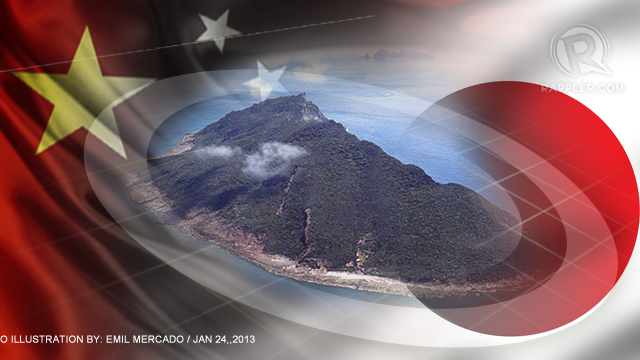SUMMARY
This is AI generated summarization, which may have errors. For context, always refer to the full article.

TOKYO, Japan (UPDATE) – Japan’s prime minister Tuesday, April 23, vowed to “expel by force” any Chinese landing on islands at the centre of a territorial row, after eight government vessels from China sailed into the disputed waters.
The latest clash over the islands came as 168 Japanese lawmakers visited the controversial Yasukuni war shrine in central Tokyo, seen as a potent symbol of Japan’s imperialist past, riling its neighbors China and South Korea.
Tokyo summoned the Chinese ambassador to Japan on Tuesday after the 8 state-owned Chinese ships sailed into its territorial waters. The flotilla is the biggest to sail into the disputed waters in a single day since Tokyo nationalized part of the archipelago in September.
Prime Minister Shinzo Abe vowed to “expel by force” any Chinese landing on the archipelago in the East China Sea.
“We would take decisive action against any attempt to enter territorial waters and to land” on the islands, Shinzo Abe told parliament in response to questions from lawmakers, adding: “We would never allow” a landing.
“It would be natural for us to expel by force if (the Chinese) were to make a landing,” he said.
Chinese ships have frequently sailed around the five Tokyo-controlled islands in recent months sparking diplomatic clashes.
The Chinese maritime surveillance ships entered the 12-nautical-mile zone off the islands, which China calls Diaoyu and Japan calls the Senkaku, around 8:00 am (2300 GMT Monday, April 22), the Japan Coast Guard said in a statement.
“It is extremely deplorable and unacceptable that Chinese government ships are repeatedly entering Japanese territorial waters,” Japan’s Chief Cabinet Secretary Yoshihide Suga said.
A group of Japanese nationalists said it had sent nine ships to the area around the islands, which are also claimed by Taiwan.
The islands are surrounded by rich fishing grounds and are believed to harbor vast natural resources below the seabed.
In a separate territorial row, relations between Tokyo and South Korea have also been strained by a dispute over a Seoul-controlled chain of islets in the Sea of Japan (East Sea).
Seoul on Monday shelved a proposed trip by Foreign Minister Yun Byung-Se to Tokyo in protest at the trips made over the weekend by Japanese cabinet ministers to the Yasukuni war shrine.
Beijing also protested Monday about the weekend visits to the shrine, which is seen by Japan’s Asian neighbors as a symbol of its wartime aggression as it honors 2.5 million war dead, including 14 leading war criminals.
China’s Foreign Ministry spokeswoman Hua Chunying told reporters that Japan must atone for its past behavior.
“Only by facing up to and repenting for its history of aggression can Japan create the future, and truly develop friendly and cooperative relations with its neighbors,” Hua said.
But the protests did not deter more legislators visiting Yasukuni on Tuesday.
Upper house member of parliament Toshiei Mizuochi confirmed that 168 Japanese lawmakers visited the shrine on Tuesday morning — the annual visit usually draws a far smaller number of legislators.
Suga, who is the Japanese government’s top spokesman, brushed off anger over the shrine visits, saying on Tuesday it was a personal matter for lawmakers.
“A visit to the Yasukuni is the matter of beliefs, and Japan ensures freedom of faith,” he said.
“Therefore, the government should not interfere with visits if they are made by cabinet members or by parliament members.”
Japan’s Deputy Prime Minister Taro Aso and Keiji Furuya, the chief of the National Public Safety Commission, separately visited the Yasukuni shrine on Sunday.
Internal Affairs Minister Yoshitaka Shindo also visited at the weekend.
Japan’s premier did not make a pilgrimage but paid for equipment made of wood and fabric, bearing his name and title, which was used to decorate an altar. – Rappler.com
Add a comment
How does this make you feel?





There are no comments yet. Add your comment to start the conversation.